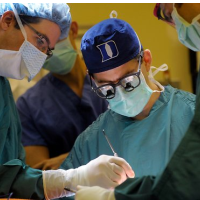Report Points Finger at Doctors for Elective Surgery Choices being “All Over the Map”

A new study (pdf) by the the California HealthCare Foundation has found that choices for elective surgery vary dramatically by region and highlights a “common problem:” Patients probably aren’t having enough input into the treatment selection.
Women with breast cancer who live in the South San Francisco area are seven times more likely to undergo a lumpectomy with radiation than those in the South Lake Tahoe area. Men with prostate cancer are 18 times more likely to receive internal, localized brachytherapy radiation treatment than men in the Oceanside area.
That wide range of treatment across California, and the accompanying wide range of costs, documented in the study indicated that the primary determination of treatment is made by the physician, rather than the patient, often reflecting prevailing medical practices in a particular community.
The study’s conclusion is that, “All too often, unfortunately, patients’ preferences are not sufficiently taken into account. The geographic variation in rates . . . reflects the medical culture of the community in which the patient resides more than informed patient choice.”
For example, the study, entitled “All Over the Map,” argues that a critical factor in early-stage breast cancer treatment should be how patients view mastectomy vs. less invasive surgery. The complex physical and psychological trauma of losing a breast, incurring additional treatment, deciding on breast reconstruction and other personal considerations may be getting short shrift in the decision-making process.
While acknowledging that geographically-influenced factors such as disease prevalence and access to certain procedures could affect the study’s findings, “More often, the variation reflects the local practice of clinicians.” One reason given for the doctors’ dominance in the decision-making process: “Patients are for the most part in the dark about differences of opinion among clinician.”
Citing other studies of patient input, the foundation’s report faulted doctors for not providing enough information. One study found doctors readily offered their opinion on a procedure but were less likely to ask the patient’s preference, while another study found that only 34% of patients said they received any scientific information on their condition or treatment. Another study reported that 41% of patients said they didn’t ask a relevant question because they weren’t sure how to phrase it or the doctor seemed too rushed to listen.
Other findings of disparity among treatment included:
- San Francisco women were half as likely as those in Redding to undergo hysterectomies;
- Berkeley women were 10 times as likely as those in Hanford to have a vaginal birth after a previous C-section delivery;
- Fullerton men were twice as likely to undergo radical prostate surgery than those in Vacaville;
- Watsonville residents were 12.6 times as likely to undergo back procedures for treatment of osteoporosis like vertebroplasty or kyphoplasty than those in Lodi.
–Ken Broder
To Learn More:
California Study: Treatments for Prostate, Breast Cancer Vary Widely, Depending on Where People Live (by Sandy Kleffman, Contra Costa Times)
Geography Has a Role in Elective Surgery Decisions, Study Finds (by Anna Gorman, Los Angeles Times)
All Over the Map: Elective Procedure Rates in California Vary Widely (California HealthCare Foundation)
- Top Stories
- Controversies
- Where is the Money Going?
- California and the Nation
- Appointments and Resignations
- Unusual News
- Latest News
- California Forbids U.S. Immigration Agents from Pretending to be Police
- California Lawmakers Urged to Strip “Self-Dealing” Tax Board of Its Duties
- Big Oil’s Grip on California
- Santa Cruz Police See Homeland Security Betrayal in Use of Gang Roundup as Cover for Immigration Raid
- Oil Companies Face Deadline to Stop Polluting California Groundwater





